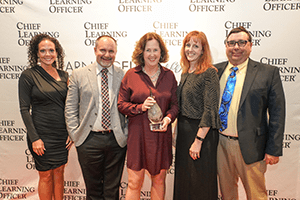
“We’re not a sexy industry. We are an industry where people say, ‘Oh, there’s that plant down the road, you don’t really want to go work there,’” said Jeannine M. Siembida, director of the Global Manufacturing Training Initiative at International Paper. With low desirability and aging employees, IP has faced massive losses to personnel.
“We had to put together a program to get ready to lose about half of our workforce in a pretty short span of time,” Siembida said.
The first step toward improvement has been bringing in new talent. To do that, IP has had to make manufacturing into a desirable field. The general public may not see it, but, Siembida said, “In fact, these are very, very good jobs.” To showcase that fact, IP teamed up with communities in its mills and used education to inform potential employees about what IP has to offer.
Bringing in new talent was only part of the problem, though. Attrition of this level meant that many of IP’s experienced workers were walking out the door. Incoming workers were filling jobs held by employees who had gained their knowledge throughout 30-year careers. Even employees who started in entry-level jobs would likely reach upper positions at rates unprecedented.
“We recognized that we really have to give them a good foundation of knowledge and safety in order to get to those levels of performance in a shorter time,” Siembida said. In 2014, the team added a New Hire Integration program to the GMTI standards to ensure new employees have the base skills they need before they even begin work.
In the past, IP mills with similar workforce turnover but without a strong training program in place faced significant downtime and reliability issues that created setbacks for the company. But this year, thanks to the NHI program and the GMTI, IP has continued to outperform. In fact, 2017 was the company’s best year ever for safety.
At IP, learning gets plenty of leadership support. Bimonthly meetings with senior leaders allow the learning team to confirm that the program is still meeting the needs of the company. Additionally, at its inception, the GMTI itself was sponsored by a senior leader within IP, according to Siembida.
Due to close involvement from leaders at all levels, the GMTI has a “homegrown” feel. “All parts of the program were developed by people who had been working in the manufacturing organizations,” Siembida said. That meant the program could be laser focused to address the specific learning needs of manufacturing positions.
When new mills require GMTI integration, IP works to maintain that homegrown touch by working in concert with existing learning programs. GMTI team members visit new mills and assess the learning strategy already in place to find areas where the program as a whole could improve before raising standards to meet the current ones. The program is rooted in collaboration, which naturally lends itself to continuous renewal. Across the company the GMTI team is devoted to “pulling together the best of the best in the facility and looking at what across all of our facilities is the best practice,” Siembida said.
Even among its currently operating mills, IP is not content to let learning fall behind. Each year, IP’s facilities hold self-audits, and every three years formal audits are conducted to ensure programs are on track.
“We have the standard learning process in place, but we know if we don’t check and adjust our process, we’re never going to get better,” Siembida said.
To continue that practice on a wider scale, IP hosts a Global Mill Learning Leader Summit at its headquarters each year. This allows individual programs to share successes and struggles and seek input from each other, ensuring teams are moving toward the best possible strategy. The summit serves as an important part of maintaining IP’s culture of learning and collaboration.
Although the GMTI was launched in 2014, in 2017 IP began the rigorous work of ensuring the program is integrated into all 41 of its mills, including the international and newly acquired. Looking forward, Siembida said that IP has “a lot of energy and work that’s going in to find out what’s going to help the learners be more effective in their positions.” This means new investments in technology like video libraries and augmented reality to make training more engaging. And the GMTI team plans to continue to improve so they can better address their changing industry.
As Siembida said, “We reserve the right to get smarter.”
Read more about the 2018 LearningElite winners.
Mariel Tishma is a Chief Learning Officer editorial intern. She can be reached at editor@CLOmedia.com.














